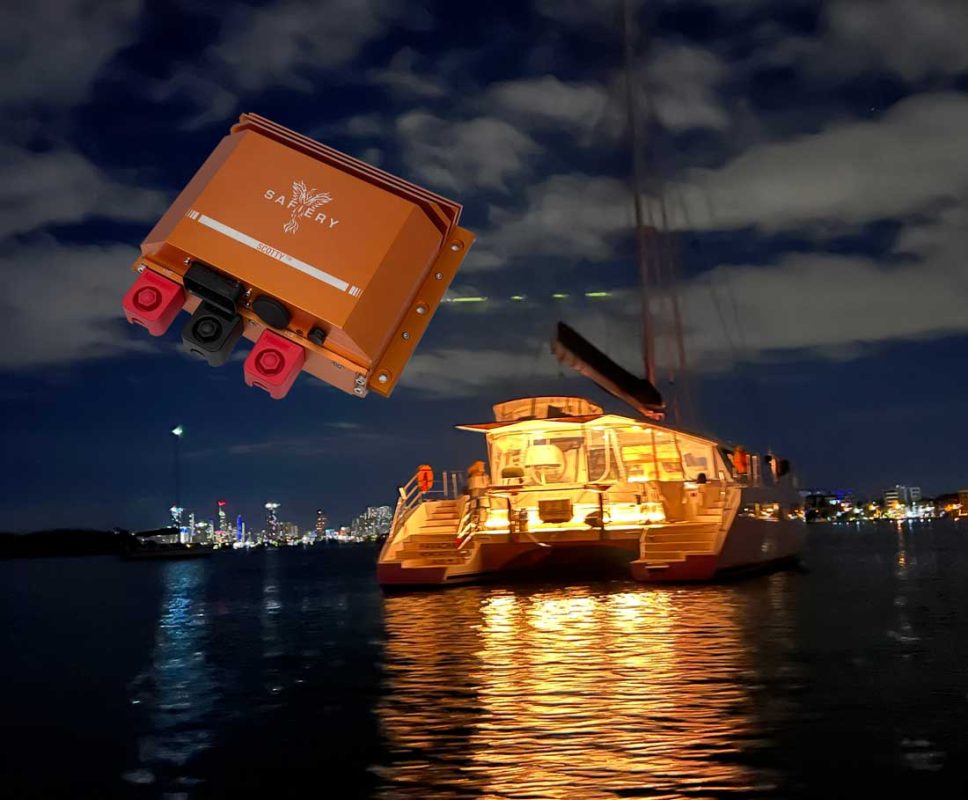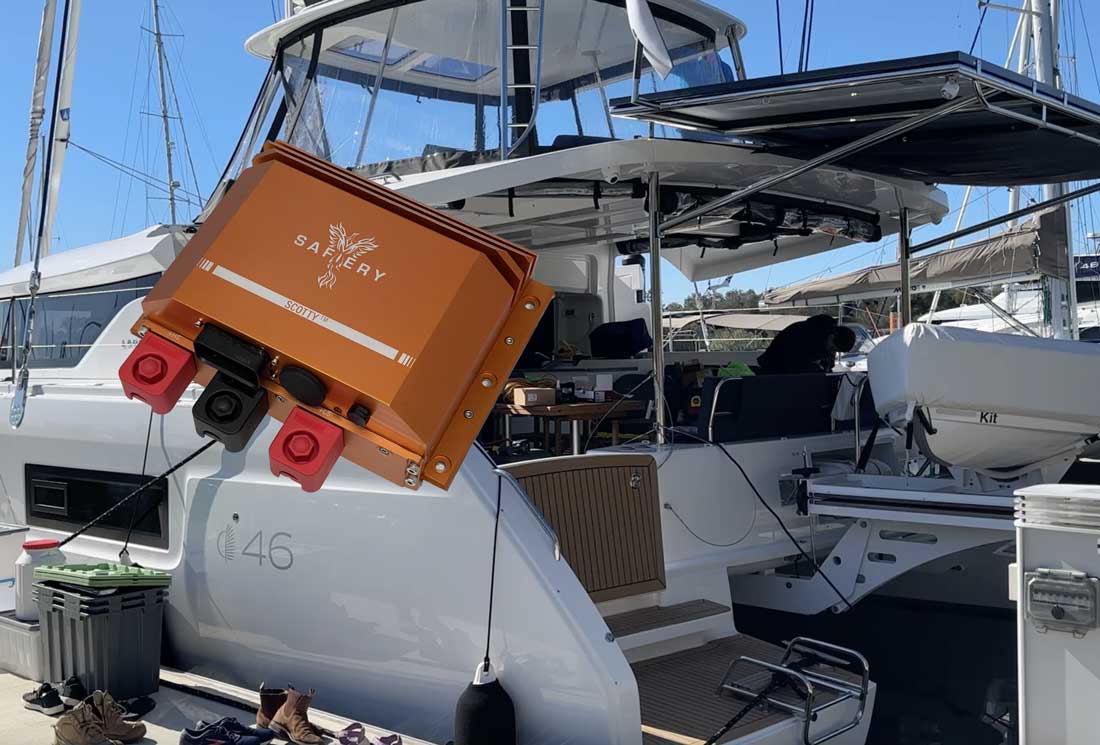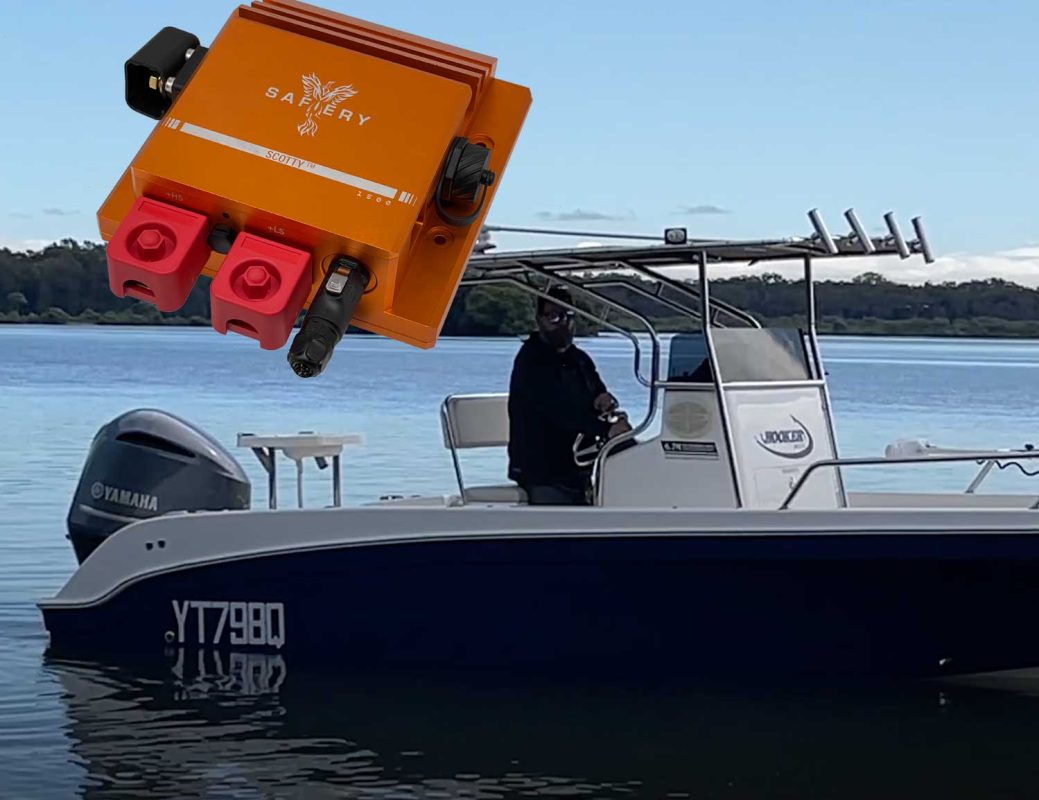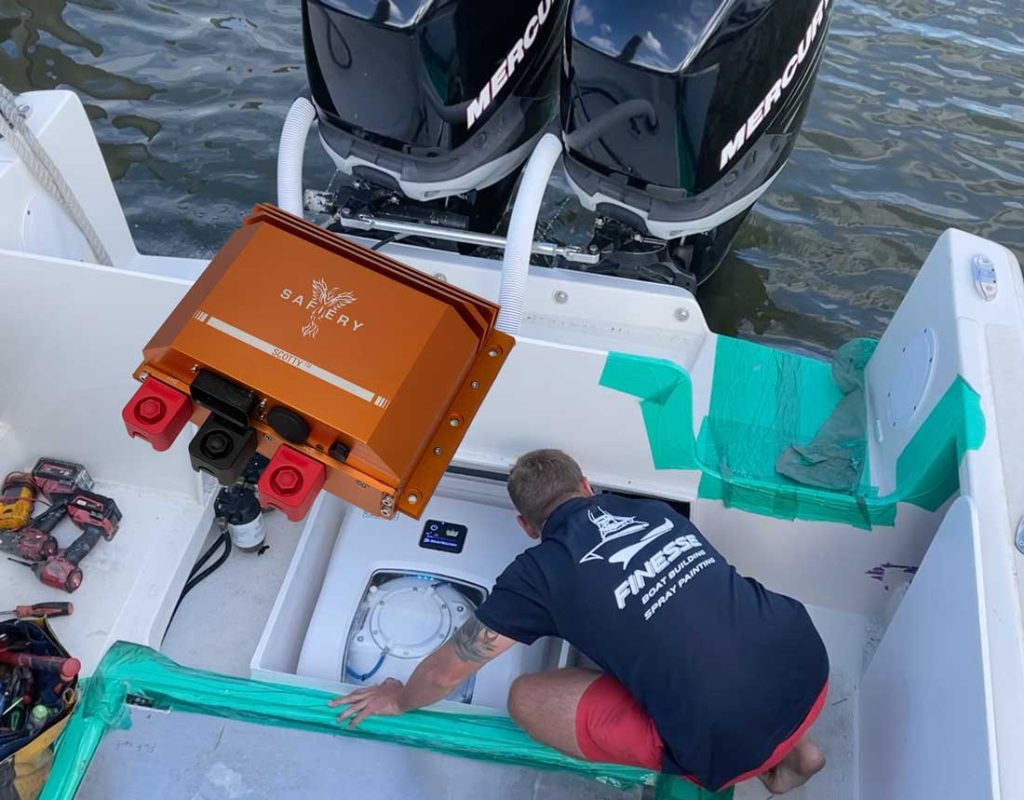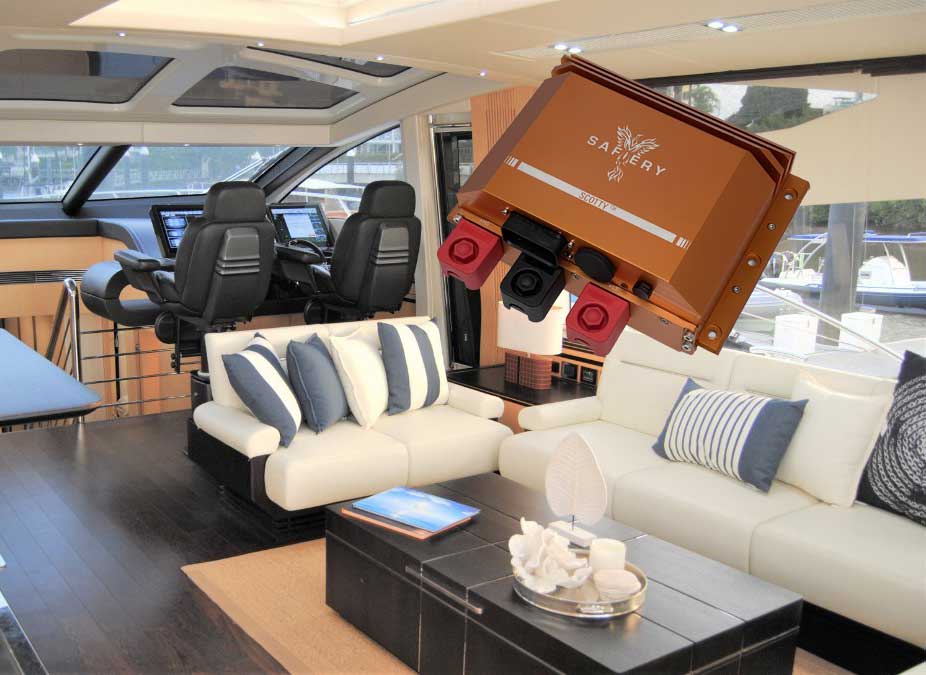Experience the power of AI with Scotty AI - your solution for intelligent, efficient, and user-friendly power management.
Scotty AI is a bi-directional DC DC power converter with an AI driven controller that:
- Automatically extracts power from an alternator.
- Auto-tunes to match the specific alternator attached.
- When engine is off, reverses power direction.
- Does not require engine RPM to optimize its output.
The clever and novel AI function has an international provisional patent:
- During an initial “auto-tuning”, Scotty AI goes through 4 phases of machine learning. At a derived voltage, a range of power loads is applied to the alternator. Under each load, the voltage breaks from derived voltage. The “voltage break profile” including voltage rate of change is analysed. This process is then repeated 3 more times at different derived voltages to capture up to 90 data points. You see the process in the video.
- Using mathematical modelling, the data points are used to form a dynamic power curve without the requirement to measure RPM. In fact, although engine speed is a key input to produced alternator power, actual RPM measurement is really an irrelevant parameter in our AI derived power curve.
- During operation, slight changes to voltage are constantly applied under load and from the resulting voltage break profile, the load is increased or decreased to match the tuned model.
- The benefit of Scotty Ai over RPM derived control is that power output changes because of alternator temperature change and net power available if additional electrical loads are applied at the alternator voltage level, are automatically accommodated. It is clean and simple single auto-tuning process of 2 minutes.
- There are 3 profiles derived during the Auto-tuning process that are labelled: “Soft”, “Medium” or “Hard”. The user can select one of these in addition to “off” from the touch display on the helm station.
- In the video, you will see the power output at the “Medium” setting is very close to the power output at the “Hard” setting. Yet the actual current is some 20-30A less at the medium setting. Less current, less power losses and less heat.
- An additional AI function is machine learning on alternator temperature and power. We have found a very wide range of operating temperatures in the engine bay. Using measured temperature on part of the alternator alone as a dampening variable is an educated guess. Rate of change of temperature is a good proxy of how hard the alternator is working when at or close to its limit. This is what we measure and machine learn. Rate of temperature change, temperature, current and voltage are all analysed for a normal range for the alternator. If the temperature variables go outside of the norm, the setting level is pushed down from “hard” to “medium” or “medium” to “soft” reducing the current. This adds a layer of protection to the alternator and is a fundamental goal of Scotty AI.
- Once Scotty AI is auto-tuned, there is no need to apply this again. No Laptop nor external program is ever needed.
- The manual is 1 page supported by extensive self diagnostics in the smartphone app. Simple text messages are used. There is a glossary of terms and explanation in the app. Firmware can be updated “Over the Air” from a smartphone.
- Reported variables include cable power losses on the alternator side and the battery side if a CAN BMS. This can be valuable in maintenance assessments.
- The Smart Touch Display is supports Scotty AI and CAN-BMS batteries with battery monitoring, alternator power extraction and alternator temperature. It also allows for adjusting the power settings at idle.
- We highlight many different applications where Scotty AI solves problems for marine users as case studies. Click on the cards below to read each one.
Redundancy for the Marine User
- With Scotty AI, the native operating voltage of the engine’s starting battery and an attached house battery is preserved. This means that if the 24v, 36v or 48V battery that Scotty AI is charging ceases to function, the user can continue operating with the native voltage system.
- This redundancy is highlighted as an emergency operating mode during lightning conditions with the Privilege catamaran owner. He disables and isolates the 48V system: batteries and inverter charger during lightning conditions and motors on the native 12V system.
Simplified House Battery for Fishing Boats with trolling motors/geo-stationary anchors.
- Trolling motors/geo-stationary anchors operate at higher voltages. Without Scotty AI, a 24V or 36V battery is required plus the charging system. If 12V refrigeration and other loads are also present, then a second house battery with charging system is required. With Scotty AI only one battery system is required. Scotty AI can charge a 36V battery from either the alternator or from the shore power source. It will be tuned for the engine(s) but will accept the fixed shore power effortlessly.
- There is a choice of locating the house battery at the 36V level or the 12V level. If the 12V level is chosen, using a pre-charge function, Scotty AI can operate the 36V load without a 36V battery. If the 36V level is chosen, Scotty AI can deliver 1500W or 3000W at the 12V level for inverters as well as small loads like refrigeration. Watch the video on a 3000W inverter load being pulled through Scotty from a 36V battery bank.
- Generally fishing boats have limited space for multiple We highlight many different applications where Scotty AI solves problems for marine users as case studies. Click on the cards below to read each one.
Simplified House Battery for Fishing Boats with a Gyro.
- Gyros consume significant energy. There is also a delay if waiting to spin up the gyro on shore power. By using a 48V battery bank, gyro users get a higher energy density in a smaller volume. This can power the gyro all night. Scotty AI can charge this battery bank AFTER the power for the 12V gyro is consumed. This gives high replenishment energy if the outboard alternators have the power capacity. Watch the video of two Verado 275hp engines, a Scotty AI 3000 and a Seakeeper 1. Electric steering consumes a lot of power so in this case study, we upgraded one of the Verado alternators to 200A from 120A.
Catamarans with no genset or users not wanting to run a genset.
- This is one of the strongest applications for Scotty AI. Each alternator can be individually auto-tuned yet the pair operate on the one Can network with the battery BMS.
- A ‘floating master” is established between the two units. Should the user be motor sailing, switching from port to starboard and vice versa results in the floating master role switching seamlessly.
- The Scotty AI 1500 has a maximum current draw of 125A at 12V and is well matched with the engine alternators fitted as standard by most European catamaran manufacturers.
Large power yachts wanting a silent night.
- It is common to find the master cabin on 100ft motor yachts within earshot of operating gensets. The owners want a silent night… and early morning while the espresso and induction is running. The battery capacity required is significant and the only practical voltage is 48V. The refrigeration is generally at the 24V level to match the native starting system. Scotty Ai not only charges from the engine alternators at 24-48V but then discharges when the engines are off. The 24V loads are significant and Scotty Ai is typically delivering up to 3000W continuously on the 24V side over night.
- Scotty AI provides both a high replenishment capability with redundancy for larger vessels with 24V alternators at 150A each. Up to two of these per engine have been fitted giving a total 16kw capacity. With two Scotty AI’s per engine, give a total of 12kW charging capacity.
- Installed systems include a 100kWh 48V house bank being replenished from 12kW Scotty AI array which is sufficient to run the saloon and helm aircon loads and electronics power while motoring without the genset running. The resulting “silent night” is gold to the owners.
Watch Video to see AI functionality in Action
Simarine
Manage your power to enjoy freedom Voltage, current, or time remaining? PICO has all the answers. The PICO battery monitor
Batteries comply with Australian Standards
Choosing Your Battery System – A Comprehensive Guide From November 18th 2023 The new Australian Standard AS/NZ 3001.2:2022 becomes compulsory.
STARship
STAR-Ship Series: A lineup of products that seamlessly blend wired CANbus and wireless Bluetooth technology at affordable price points. The
power packs for Catamarans
Privilege 515 Power Upgrade of 20kWh 48V overlay on top of 12V factory system Walk Through with Owner Will Peters.
Fishing Boat with Gyro Scotty AI Charging
FISHING BOAT CASE STUDY 25ft “Bertram” Fishing Boat with Gyro in Tropical North Qld near Great Barrier Reef. Its 100
Electric Hot Water
Electric Hot Water vs LPG? Safer Zero operating cost if using solar Takes less space Efficiency is a little better
SCOTTY AI for SILENT NIGHTS
Privilege 51.5 owners wanted Silent Nights on the water. They also wanted to run “Zero Genset” and installed 3.2kW solar. The 12V DC loads are around 600W+ without winches/windless. A 48V 20kWh Lithium bank was installed as an energy overlay.
As a backup to solar two Scotty AI’s provide both a high replenishment capability and redundancy. When Scotty’s are off, the 12V alternators will continue to charge the existing 12V house battery.
With significant 12V loads, the available power to Scotty AI varies widely. Scotty AI’s patent pending auto-tuning maximizes the charging power prioritizing the 12V loads.
Should one alternator fail for some reason, the Scotty AI associated ceases operation automatically and the floating master role switches if required
The Smart Touch Display allows the skipper to set the alternator engine load to Soft, Medium or Hard depending whether motor sailing or solar back up power without running the Genset.
Read More…
SCOTTY AI in NEW CATAMARAN
For new-built catamarans in the 36-46ft size, the factory fitted 12V lithium house battery bank stays as installed and Scotty AI and a large capacity additional house bank at either 24V or 48V is an overlay energy system.
When running the engines, Scotty AI is auto-tuned with the “lithium house” enabled. The patent-pending auto-tuning is done on either engine independently. Scotty AI is then ready to run.
With either or both engines running, Scotty Ai waits till the house battery is significantly charged at 90%+ before cutting in and extracting power up to 3000W per engine. (the factory fitted engines on popular brands have 120A capacity at 14.4V and the 1500W Scotty AI model is a perfect fit)
When the engines are off, Scotty AI delivers DC power back to the factory fitted 12V house bank to keep it always in the circa 90% band.
Read More…
SCOTTY AI with 36V in FISHING BOATS
Fishing boats with GPS-guided propulsion/autopilot packages and/or virtual anchor systems using high torque 36V motors have two options that significantly simplify a single house battery bank design:
- Scotty AI can simply provide the 24V or 36V load (generally up to 1500W is sufficient) on demand without the need for a 36V house battery. This can be from a single 12v house battery design.
- Scotty AI can simply charge a 24v or 36V Auxiliary battery and use the bi-directional feature to supply the 12V loads without the need for a 12V house battery.
- High loads, including up to a 3000W inverter can be used on the 12V side pulling power through Scotty AI from the 36V Auxiliary battery.
- The result is a simplified single auxiliary battery system.
SCOTTY AI in FISHING BOATS & GYRO
For outboard engines, the features above allow the engine to idle with little or no net output, then ramp up the power to a full 3000W at cruising RPM (provided the outboards have alternator capacity). This unique and innovative product allows fishing boats to run gyro’s and other high demanding loads with a battery bank being charged at the same time the gyro is running.
- The vessel can leave the dock immediately if the gyro application is for a “restful night” at anchor later in the day.
- Scotty AI allows the gyro power demand to have priority at any engine RPM
- Once the gyro demand has reduced after spin up, Scotty AI will extract power for the auxiliary battery if required.
- Once at anchor, Scotty AI will direct power from the auxiliary battery bank back to the gyro as it is fully bi-directional DC DC.
- Scotty AI can direct up to 3,000W to the gyro and any other 12V (or 24V) loads.
Read More…
SCOTTY AI in LARGER YACHTS
Scotty AI provides both a high replenishment capability with redundancy with 24V alternators at 150A each. Up to two of these per engine have been fitted giving 16kw capacity. Two Scotty AI’s per engine can charge at 12kW.
An 48V Lithium bank is installed as an energy overlay. The existing 24V AGM house bank is preserved.
Scotty AI is auto-tuned per alternator. When all Scotty AI units are activated a patent pending ‘floating master” is established between.
Should one alternator fail for some reason, the Scotty AI associated ceases operation automatically and the floating master role switches if required
If the Scotty AI’s are charging the 48V auxiliary battery and this operation is stopped, the vessel can continue to run on the 24V AGM house bank.
Installed systems include a 100kWh 48V house bank being replenished from 12kW Scotty AI array which is sufficient to run the saloon and helm aircon loads and electronics power while motoring NO Genset. “Silent Nights”
Introducing Scotty AI: A Revolutionary Power Converter
Scotty AI is a cutting-edge bi-directional DC DC power converter, equipped with an AI-driven controller that redefines power management in marine applications.
Key Features:
- Intelligent Power Extraction: Automatically draws power from an alternator, adjusting to match the specific alternator attached.
- Reverse Power Direction: When the engine is off, Scotty AI reverses power direction for optimal efficiency.
- RPM Independent: No need for engine RPM measurement to optimize its output.
The Power of AI:
Scotty AI's unique AI functionality, protected by an international provisional patent, uses machine learning and mathematical modelling to form a dynamic power curve without the need for RPM measurement. This ensures efficient power output adjustments based on alternator temperature changes and additional electrical loads.
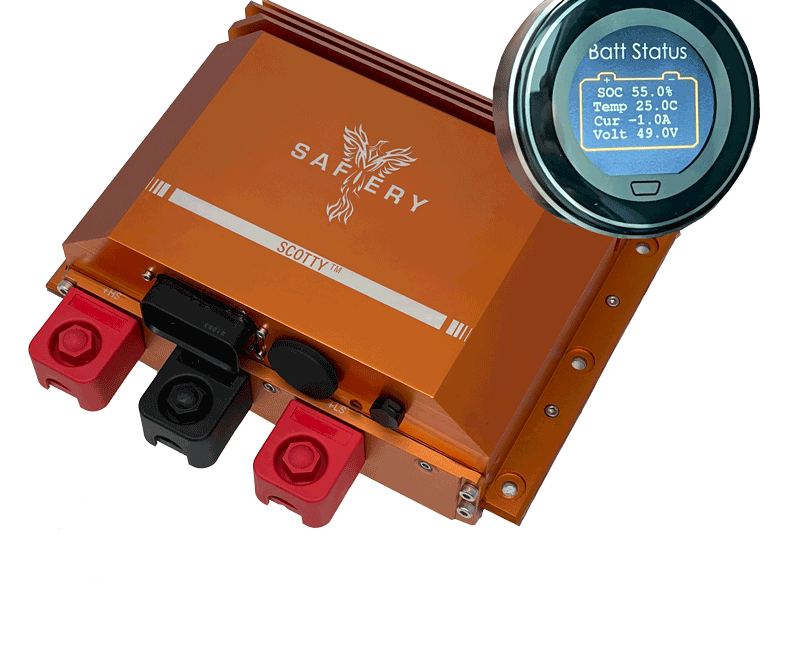
Boat Owner Problems Scotty Solves:
- Auxiliary or “house” battery capability is increasingly important for a wide range of marine vessels. This energy capacity needs constant replenishment to be sustainable.
- There is a group of marine vessels that have limited genset capability: Fishing boats with auto-positioning anchor, catamarans that do not want to install or operate a factory genset, pleasure vessels with gyro’s, any vessel wanting a “silent night”.
- These vessels will want to charge from their propulsion engine alternator. The higher the replenishment the better.
- A common problem with alternator charging is the wide power output range of propulsion engines from idle to cruising rpm.
- A fixed power DC DC must be undersized to match the minimum power capacity to be viable. This limits replenishment energy to the auxiliary battery.
- An external regulated alternator may be used for non-outboard applications but requires RPM sensing to optimize power produced. An external regulator also needs careful tuning to RPM and alternator temperature. It may also need an additional shunt installed to capture the alternator current.
- Outboard engines may have a very wide range of output power and it is important not to choke this at idle, particularly after coming off a long run and the alternator is hot. The output may be just enough for the EFI power demand. Any significant DC DC load may adversely affect this.
- Outboard Engines and 12V gyro combinations have the added complication of big loads on the engine if the gyro is started up without shore power. A large AC powered charger is needed and the user has to wait the lengthy time for the gyro to spin up before departing particularly if there is a speed limitation between the dock and blue water.
- It is popular for new built catamarans in the 36-46ft size to have factory fitted 12V lithium house battery bank and no genset. Solar and alternator replenishment is generally limited. Adding additional auxiliary capacity to these “brand new” vessels without impacting the inherent electrical design and/or warranty is limited to just increasing battery capacity and weight. Increasing replenishment capacity is limited to solar.
- Fishing boats with GPS-guided propulsion/autopilot packages and/or virtual anchor systems using high torque 36V motors require a second 36V auxiliary battery and all the charging systems for it. This generally includes AC charging before boat is launched as well as engine changing in water. These boats generally have 12V loads for fridges and electronics as well and therefore a second 12V auxiliary battery system. The resulting power conversion and battery systems is complex and uses a lot of valuable space.
- Larger vessels with significant engine power capacity typically have 24V starting and engine controls with 24V alternators. If these are exchanged for 48V externally regulated alternators for high replenishment power, the vessel has limited redundancy should an alternator or the regulator or a 48V battery system problem develop. In the case of the latter, it may mean a dead ship.
Scotty Solves these problems with Simplicity:
- Patent Pending “Auto-tuning” by the user. This is done by running the engine at idle and touching “auto-tune” on the Smartphone app. In the following two minutes, Scotty establishes a mathematical power curve for the alternator by placing over 90 load points and assessing the voltage break point for each load value. This mathematical curve is then extrapolated to the full output value of the alternator. The 90+ steps are visible on the Smartphone app. At the end of this, Scotty is ready to go! There is no need for engine RPM.
- Patent Pending 3 different load settings: “Off”, “Soft”, “Medium”, and “Hard” lets the user decide how hard they want to drive the alternator. Changing these settings are either done by the Smart Touch Display at the helm (IP67) or from the Smartphone App.
- Patent Pending “AI” is machine learning on alternator temperature, alternator current and alternator voltage. The learning is to determine is the increase in alternator temperature because of a high sustained load on the alternator or just long run hours in a high ambient temperature. If it determines it is most probably the former, the load setting is dialled back a step. The benefit of this “AI” outcome over just turning down the power, is the user still gets all the benefits of variable output power if the engine is subsequently reduced in RPM. In this case the power demand will reduced as established in “auto-tuning”.
- For outboard engines, the features above allow the engine to idle with little or no net output, then ramp up the power to a full 3000W at cruising RPM (provided the outboards have alternator capacity). This unique and innovative product allows fishing boats to run gyro’s and other high demanding loads with a battery bank being charged at the same time the gyro is running.
- For outboard engines running a gyro:
- The vessel can leave the dock immediately if the gyro application is for a “restful night” at anchor later in the day.
- Scotty AI allows the gyro power demand to have priority at any engine RPM
- Once the gyro demand has reduced after spin up, Scotty AI will extract power for the auxiliary battery if required.
- Once at anchor, Scotty AI will direct power from the auxiliary battery bank back to the gyro as it is fully bi-directional DC DC.
- Scotty AI can direct up to 3,000W to the gyro and any other 12V (or 24V) loads.
- For new-built catamarans in the 36-46ft size, the factory fitted 12V lithium house battery bank stays as installed and Scotty AI and a large capacity additional house bank at either 24V or 48V is installed.
- When running the engines, Scotty AI is auto-tuned but the “lithium house” option is enabled first. The patent-pending auto-tuning is done on either engine independently. Scotty AI is then ready to run.
- When running the engines, Scotty Ai waits till the house battery is significantly charged in the 90%+ band before cutting in and extracting power up to 3000W per engine. (the factory fitted engines on popular brands have 120A capacity at 14.4V and the 1500W Scotty AI model is a perfect “out-of-the-box fit)
- When the engines are off, Scotty AI delivers DC power back to the factory fitted 12V house bank to keep it always in the circa 90% band.
- Fishing boats with GPS-guided propulsion/autopilot packages and/or virtual anchor systems using high torque 36V motors have two options that significantly simplify a single house battery bank design:
- Scotty AI can simply provide the 24V or 36V load (generally up to 1500W is sufficient) on demand without the need for a 36V house battery. This can be from a single 12v house battery design.
- Scotty AI can simply charge a 24v or 36V Auxiliary battery and use the bi-directional feature to supply the 12V loads without the need for a 12V house battery.
- High loads, including up to a 3000W inverter can be used on the 12V side pulling power through Scotty AI from the 36V Auxiliary battery.
- The result is a simplified single auxiliary battery system.
- Scotty AI provides both a high replenishment capability with redundancy for larger vessels with significant engine power capacity.
- Typically, larger capacity 24V alternators to 4kW each are installed.
- In some vessels two of these per engine have been fitted giving 8kw capacity each and 16kW in total.
- The existing 24V house bank is preserved and this is generally AGM.
- There can be two Scotty AI’s per engine, giving a total of 12kW charging capacity.
- Scotty AI is again tuned per alternator (as each one may have slightly different performance) and the units are individually auto-tuned independently.
- When both Scotty AI units are then activated a master is automatically established. A patent pending ‘floating master” is established between the two.
- Should one alternator fail for some reason, the Scotty AI associated ceases operation automatically and the floating master role switches if required
- If the Scotty AI’s are charging a large 48V auxiliary battery and this battery’s operation is stopped, the vessel can continue to run on the 24V AGM house bank.
- Installed systems include a 100kWh 48V house bank being replenished from 12kW Scotty AI array which is sufficient to run the saloon and helm aircon loads and electronics power while motoring without the genset running. It also gives a “silent night”.
About the development of Scotty AI
- Scotty AI was built with the goal of plug-n-play: AI self-tuning, No more than a 1 page manual, on board diagnostics and “OTA” firmware updates. No Laptop nor external program is ever needed.
- Deep domain expertise was built up commissioning over 400 installations:
- Using externally regulated alternators at 12V, 24V and 48V
- Using fixed power DC DC devices up to 1500W
- Using variable power DC DC with basic control
The experience from these jobs over a 3 year period, lead to the development of Scotty AI.
- Patent Pending International Patent.
- There is over 5,000 lines of code in Scotty AI excluding the libraries at the SOC.
- The Smart Touch Display is also programmed to support Scotty AI
- Developed by a multi-cultural team in Australia for marine, 4WD, RV and high-power service truck applications.
- Scotty AI is endorsed by the Australian and Queensland Govt with R&D funding and Export support
7 Scotty Models Available with an IP rating up to IP67.
- Scotty AI 1500: 12V to between 20V and 58V Boost and Buck mode bi-directional DC DC at 125A max on the low side (typically 1500W) Available in 2 models: IP 65 and IP67
- Scotty AI 3000: 12V to between 20V and 58V Boost and Buck mode bi-directional DC DC at 250A max on the low side (typically 3000W) Available in 2 models: IP 64 and IP66
- Scotty AI 3000/24: 24V to between 32V and 58V Boost and Buck mode bi-directional DC DC at 125A max on the low side (typically 3000W) Available in 2 models: IP 64 and IP66
- Scotty AI Meteor: 12V to between 20V and 58V Boost and Buck mode bi-directional DC DC at 125A max on the low side (typically 1500W). This model plugs into the 48V Meteor Lithium Battery which is all IP67 and does not require a low side battery.
FISHING BOAT CASE STUDY
25ft “Bertram” Fishing Boat with Gyro in Tropical North Qld near Great Barrier Reef.
Its 100 nm to the Reef fishing spot. Owner and family travel out Saturday Morning return Sunday Afternoon.
Owners Requirements:
- Ability to start gyro without shore power as boat goes into water at a boat ramp.
- Owner stays out on reef overnight with gyro and air-conditioner running, wanting a cool “silent night”.
- Owner wants to run high performance sound system “Wet Sounds” which draws 120A at 12V while cruising and 30A while at anchor without stopping gyro.
- Owner wants to use induction cooktop (No propane for safety) in evening and espresso coffee machine at breakfast.
- Double Drawer fridge/freezer running 24/7 for fish catch.

